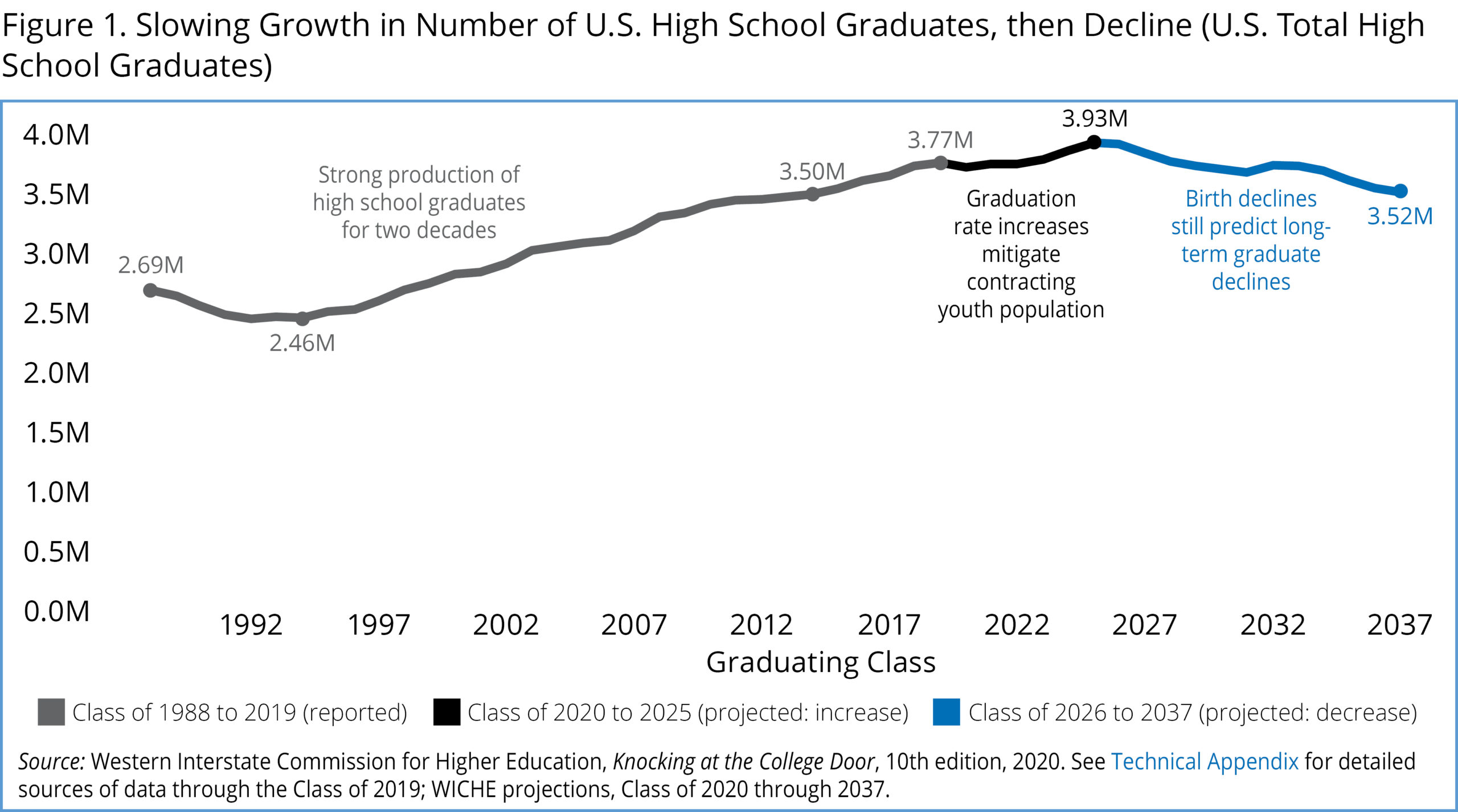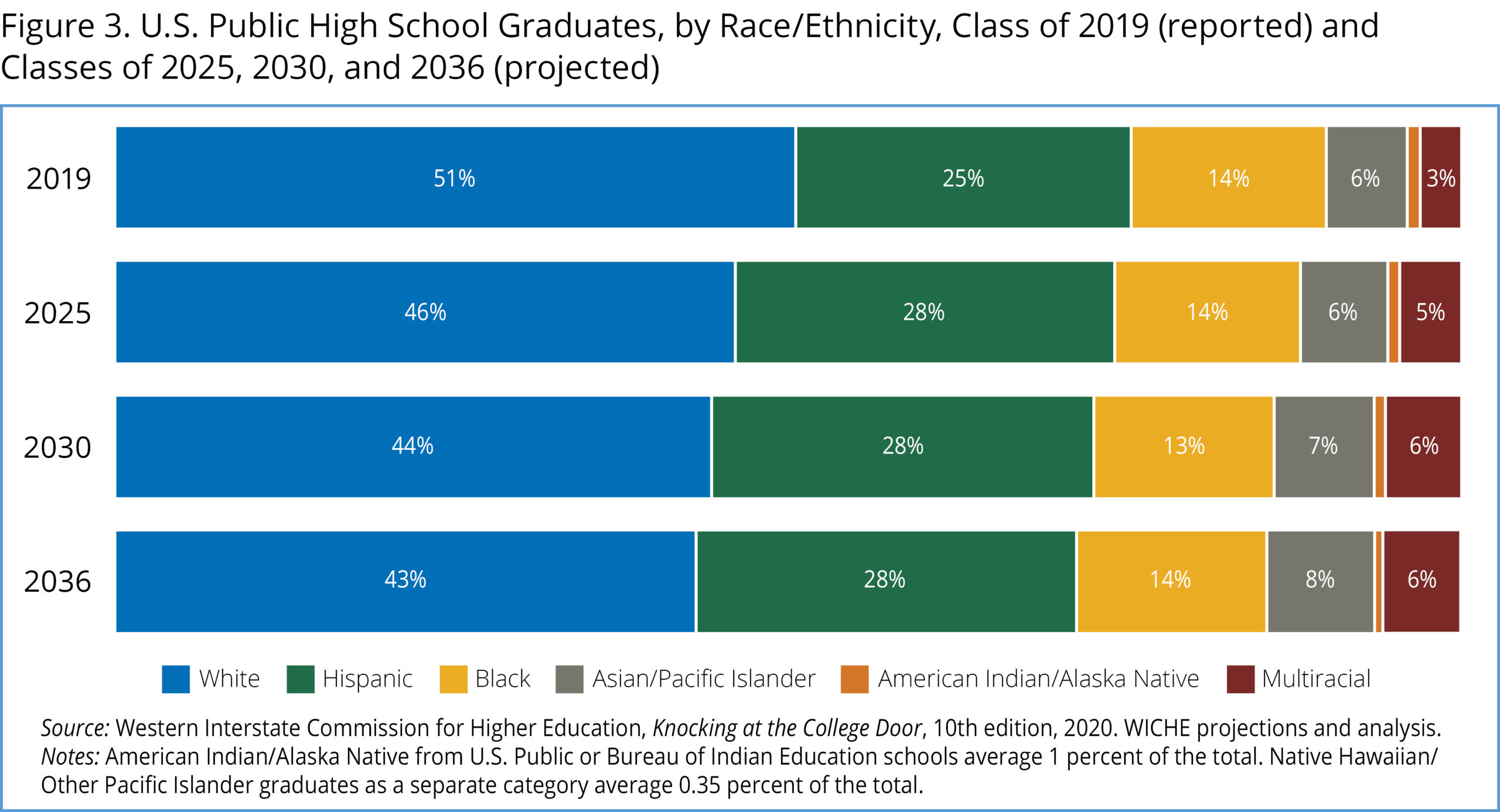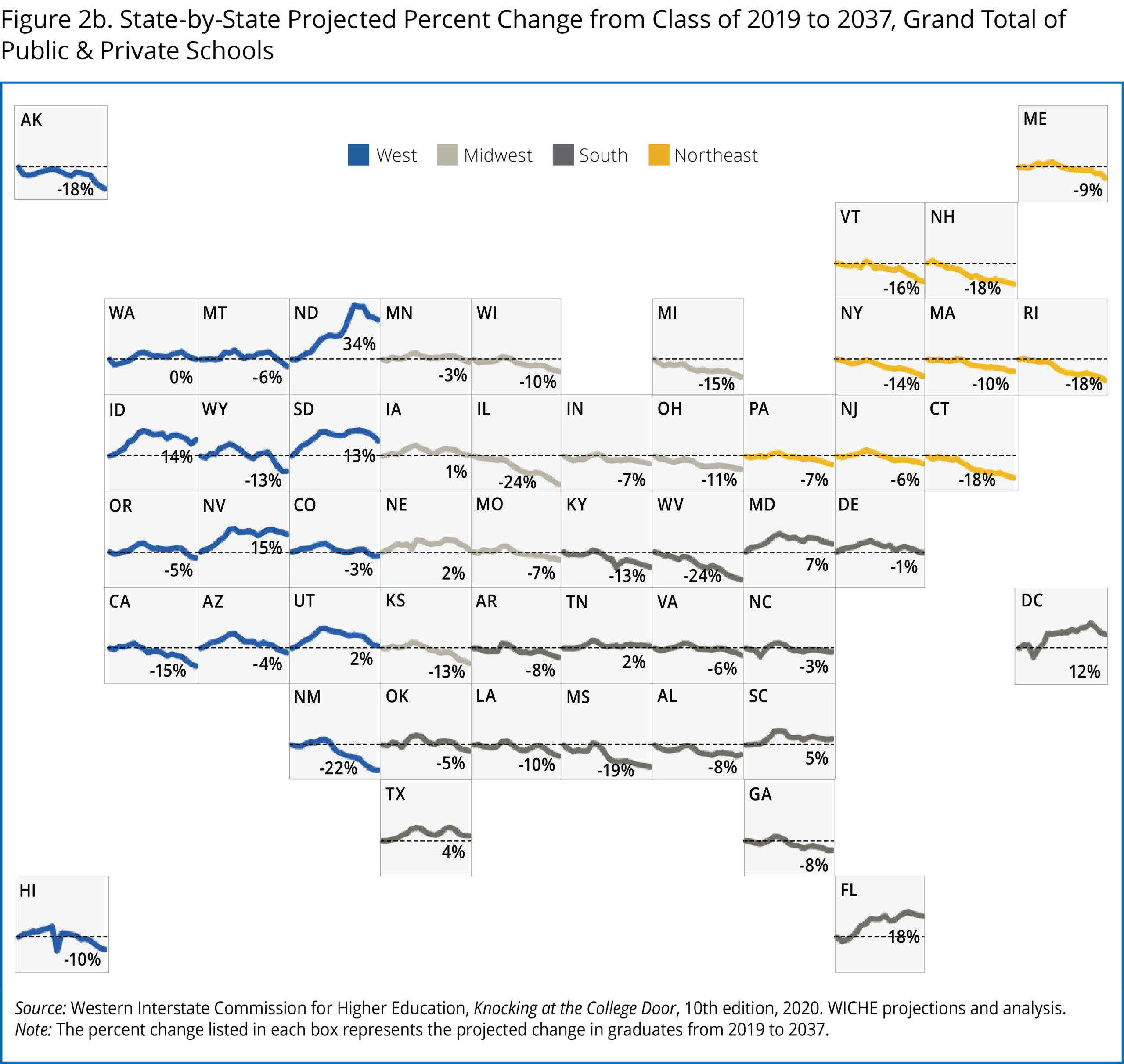In recent years, high-school graduating classes have been larger than projected, but the forecast is for those numbers to shrink after 2025. At the same time, diversity is increasing: 24 states are projected to have nonwhite students comprise the majority of their graduates within 15 years. However, the impact of COVID-19 on graduation rates remains uncertain.
Nationwide, both public and private high school graduation rates have increased in recent years, and the increase is projected to continue in the near future. The overall number of U.S. high school graduates will climb for the next five years (10 percent higher than was previously predicted) to a peak in 2025 before declines in the birth rate and smaller elementary school cohorts will drive a downturn, according to the tenth edition of the report, Knocking at the College Door: Projections of High School Graduates, released in December 2020 by the Western Interstate Commission for Higher Education (WICHE).
According to the report, the country produced about 3.8 million high school graduates in the class of 2019. The number of high school graduates is projected to peak at 3.9 million with the class of 2025. After 2025, the U.S. should expect successively fewer annual numbers of graduates in virtually every graduating class with the class of 2037 projected to be about the same in number as the class of 2014 (3.5 million).

Projected Total U.S. High School Graduates
Source: Western Interstate Commission for Higher Education, Knocking at the College Door, 10th edition, 2020. See Technical Appendix for detailed sources of data through the class of 2019; WICHE projections, class of 2020 through 2037.
Increasing Diversity of Graduating Classes
The demographic trends also reveal that students of nonwhite racial and ethnic backgrounds in the United States will continue to represent an increasing share of graduating classes, the report says. Numbers of white non-Hispanic public high school graduates are predicted to wane almost universally across states, and graduates from other racial and ethnic groups (especially Hispanic, Asian/Pacific Islander, and multiracial students) will become the main source of increases in the number of graduates over the years projected.

U.S. Public High School Graduates by Race/Ethnicity
Source: WICHE, Knocking at the College Door, 2020
Nationally, the class of 2036 will have about 300,000 (19 percent) fewer white non-Hispanic public high school graduates than the class of 2019, the report says. Thirty-three states are projected to have fewer white public high school graduates in all future years (or only experience single-year marginal increases). Correspondingly, white public high school graduates are projected to comprise less than half of all public high school graduates in at least 24 states in the early to mid-2030s.
Digging Deeper into the Trends
“While the overall number of graduates is expected to peak in the mid-2020s, the projected decline may not be as severe as previously anticipated due to improvements in graduation rates that we saw pre-pandemic,” says Dr. Demarée Michelau, president of WICHE. “Future declines could be further mitigated if the nation continues to improve graduation rates, particularly among underserved students, or conversely, they could be exacerbated if impacts related to COVID-19 erode the progress we previously made. Our education system—from kindergarten through postsecondary—will need to focus attention on serving diverse and nontraditional college-going populations to meet the needs of both individuals and our economy.”
WICHE researchers recognize that race/ethnicity is an incomplete way of understanding the diversity of graduates. They note that none of these race/ethnicity categories is its own homogeneous group. But the federal race/ethnicity categories are one of the few ways researchers can disaggregate the data in the projections. The researchers also note that race/ethnicity frequently overlaps with other relevant characteristics, such as student socioeconomic status. For example, in 2019, 26.4 percent of Black children and 20.9 percent of Latinx children were living in poverty compared to just 8.3 percent of white children. So, at a minimum, these projections of an increasingly diverse student population suggest that policymakers, schools, and colleges need to carefully examine whether they are in the best position to serve our nation’s students, researchers say.
Many of the findings vary by region and state—and even within individual states—notes Peace Bransberger, senior research analyst at WICHE and the lead author of the report. “In the near term (up to the class of 2026), the national increases in the numbers of high school graduates will be driven by the South and the West while the Midwest and the Northeast will remain flat. However, the projections for the decade between 2026 and 2037 suggest significant decline in all regions. All but the South (7 percent fewer graduates) are projected to see graduating classes decrease in size by 12 to 13 percent,” Ms. Bransberger says.

Uncertain impact of COVID-19
The WICHE report, which is revised every four years, will be updated as soon as information is available on the impact of the COVID-19 pandemic on graduates past 2019. The most recent data available to build these projections are from the class of 2019 and earlier, meaning that the initial impact of the pandemic is not represented.
While WICHE’s projections over the past 40 years have proven to be consistently accurate—in many years within two or three percent of the actual numbers subsequently reported—researchers note that COVID-19 is something of a wild card.
“COVID-19 is having a major impact on educational outcomes in obvious and unknown ways, which could lead to fewer students graduating in the long run, though some preliminary research suggests that we may have had an uptick in numbers of graduates for the class of 2020, due in part to flexibility granted by schools and districts,” notes Dr. Patrick Lane, vice president of policy analysis and research at WICHE. “We just don’t have the information yet to draw firm conclusions but will update our findings as soon as new data are available.”
Methodology and Implications
Key to understanding and correctly interpreting these projections is understanding the methodology at a basic level. Essentially, the projections show what would happen if the trends observed in the data over the past five years continue, given the existing observed populations of students and births. These projections are not predictions of what WICHE analysts think will happen, but simply what the numbers show would happen if everything proceeded on the course that was underway up through the class of 2019. While this approach to modeling is reasonably accurate, especially in the near term, it represents an assumption that retention, progression, and graduation rates will stay the same in the coming years.
Previous editions of Knocking at the College Door have garnered significant attention for projecting the national peak in 2026 and the subsequent decline. This trend is still consistent and drawing closer each year. Despite overall improvements in high school graduation rates, the decline in birth rates during the Great Recession is still the driving factor in projected declines beginning in the mid-2020s. Although improvements in graduation rates are certainly a good news story, much more remains to be done, particularly to generate improvement in serving students of color.
A Crucial Source of Information for 40 Years
The report, Knocking at the College Door: Projections of High School Graduates, has been released every four years for four decades with generous support from The College Board and using WICHE funds.
The data in the report and accompanying materials provided on the WICHE website are designed to help states and others target resources effectively to meet the education and workforce needs of current and future populations and industries.
WICHE collected the data from every state for public high school graduates through 2019. The report fills a wide information gap since the U.S. Department of Education has not published high school graduate counts since those for 2012.
The report projects the number of high school graduates disaggregated by public and private schools and race and ethnicity out to 2037 at the state and regional levels. It is one of the most widely cited sources of comprehensive and reliable data on the future size and composition of high school graduating classes across the nation.
“Data like these are crucial for efforts to improve racial equity throughout the educational system and for a range of policy making, economic development, and higher education planning needs,” says Dr. Jessica Howell, vice president at the College Board. “Knocking at the College Door provides policy makers, college admissions professionals, counselors, school leaders, and researchers with important data.”
The online report is accompanied by a new, interactive data tool and can be downloaded at www.knocking.wiche.edu/. Readers can view the data by specific regions and states, see growth and declines for different demographic groups, and download individual state profiles.
© Cognia Inc.
This article may be republished or reproduced in accordance with The Source Copyright Policy.
The information in this article is given to the reader with the understanding that neither the author nor Cognia is in engaged in rendering any legal or business advice to the user or general public. The views, thoughts, and opinions expressed in this article belong solely to the author(s), and do not necessarily reflect the official policy or position of Cognia, the author’s employer, organization, or other group or individual.

